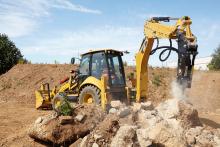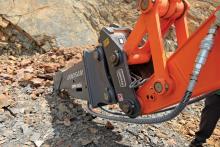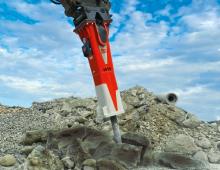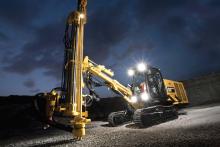
Hydraulic breakers are proving more popular for primary winning in quarries than ever before. Mike Woof visited Lopardo quarry in Italy to find out why
Nestling among the steep tree-covered hills close to the small town of Brienza near Potenza in Southern Italy lies the Lopardo quarry. The site covers a comparatively small area but the quarry has high walls because of the surrounding hills and this is a far more modern and efficient operation than its dimensions might suggest.
This compact quarry was started by the eldest of the Lopardo brothers, Rocco, in 1973 and he was later joined in running the business by family members Salvatore and Cataldo.
Output from the quarry is around 150,000m3/year and the current site has around five years worth of production left before the boundaries of the permission area are reached. However the brothers have already started the applications process for a new site nearby.
The quarry site is actually owned by the local municipal council and the Lopardo brothers pay to operate the quarry as a concession. The stone is used for an array of applications with much of the production going into the road construction market, either for direct use as an aggregate base course, or into asphalt or concrete mixes. The brothers also own a concrete business and buy in cement to mix with some of their own aggregate. Unlike some quarrying operations however, the fines are not a waste product and are used in glass manufacturing to make car windscreens.
While the firm has been using hydraulic hammers for secondary breaking for many years, it is notable that in the last couple of years the firm has switched from drilling and blasting to using
There were several reasons for this switch. Firstly, an increase in the cost of explosives meant that the cost benefits of this method had largely evaporated. Secondly, the ever tougher restrictions on the use of explosives due to stringent security and environmental requirements meant that there were more and more legal hoops to be jumped through and an ever increasing mound of paperwork to be dealt with. For security reasons the quarry workers had to have photo ID (as well as explosives training) while the operation required a live video feed to the police station for instance.
Meanwhile each blasting session required vibration monitoring to ensure that the shock waves generated were within acceptable limits. Salvatore Lopardo explained that this situation was becoming too complex and that as the firm had plenty of good experience using hammers for secondary breaking, it had become apparent that it would be far easier to start using them for primary winning as well.
There have been knock-on benefits as well, as switching to using the breakers has resulted in the aggregate being produced having fewer micro-cracks, making it a better quality product. Meanwhile the massive reduction in the noise and vibration, as well as the elimination of any fly-rock, has provided major environmental benefits that are likely to be beneficial for the necessary approval process for the new quarry site that the Lapardo brothers have applied for.
The tough environmental requirements now being applied across Europe's quarrying industry previously helped fuel this switch to using breakers for extraction instead of explosives. Hydraulic breakers have now been used in European quarries for primary winning for 15 years or more on site where there are few other options, when a site is close to housing, for example.
However in recent times economic factors have also come into play. Hydraulic breakers have improved to such an extent that they offer a dependable production option, while the spiralling price of explosives has ensured that primary winning with a hydraulic hammers is also cost-effective.
Steady advances in breaker design and construction from the major manufacturers have yielded major gains in power, reliability and productivity while the breaks in output resulting from both scheduled and unscheduled downtime have been reduced. Automatic tool lubrication is now a standard feature on large breakers from all of the major manufacturers and this has helped extend wear life considerably. Advances in materials technology have provided steels for use in critical components such as tools, cylinders and pistons that last longer, with better heat treatment processes further aiding wear life.
Like several of the other major breaker manufacturers, Indeco has made noticeable gains in bush and seal design. This ensures that dirt and other contaminants are kept out of the breakers, improving wear life and helping extend service intervals.
In addition the current generation of excavators used as carriers are much better able to cope with the stresses exerted by hydraulic breakers. Booms and dippers no longer crack under the strain while hydraulic systems are more oil tight and less prone to leaks. Carriers also have better hydraulic cooling, resulting in fewer stoppages due to overheating.
The only barrier to productivity in recent times has been climactic. With South Eastern Europe having been hit by a heatwave that has seen ambient temperatures pushed as high as 47ºC, this turned the quarry with its highly reflective rock surface virtually into a furnace at the hottest times of the day. As a result operations were only carried out in the morning, the afternoons simply proving too hot for work to continue comfortably.
The dolomitic stone at the quarry has a rock hardness of 110 N/mm2 and has a high silicate content, which makes it highly abrasive so to extend tool life the firm actually welds up the ends of the breaker tools. Despite the abrasive stone, the Indeco breakers have proven reliable in the conditions, achieving good productivity and utilisation. The MES9000 (mounted on a 45tonne class
Once the rock has been broken out it is taken to the crusher circuit and then screened. A
The site has a mix of machines in its fleet with the Fiat-Hitachi FH-450-3 being the largest, as well as a 30tonne Fiat-Hitachi machine, a Cat 325B, a new
Also on-site is a 1976 vintage Cat D8K bulldozer that is still fired up occasionally when required for clearing up the site or for smoothing the haul roads. However the old










